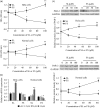Inhibition of protease-activated receptor-2 induces apoptosis in cervical cancer by inhibiting signal transducer and activator of transcription-3 signaling
- PMID: 30700181
- PMCID: PMC6421370
- DOI: 10.1177/0300060518820440
Inhibition of protease-activated receptor-2 induces apoptosis in cervical cancer by inhibiting signal transducer and activator of transcription-3 signaling
Abstract
Objective: The present study explored how the inhibition of protease-activated receptor-2 (PAR-2) induced proliferation and apoptosis in cervical cancer in vitro and in vivo.
Methods: mRNA and protein expression of PAR2 and signal transducer and activator of transcription-3 (STAT-3) was determined by quantitative real-time PCR and western blotting. The proliferation and apoptosis of cervical cancer cells were assayed by the cell counting kit-8 kit, flow cytometry, and western blotting. The effects of PAR2 inhibition on cervical cancer were also examined in BALB/c nude mice in vivo.
Results: SLIGRL-NH2 (SL), a selective PAR-2 agonist, promoted proliferation and inhibited apoptosis of healthy cervical cancer cells and HeLa cells, while the PAR-2 antagonist FSLLRY-NH2 (FS) inhibited proliferation and led to apoptosis. SL also promoted the activation of STAT-3, while FS inhibited it and inhibited cancer growth in vivo.
Conclusion: FS inhibited cervical cancer by reducing proliferation and inducing apoptosis by interfering with STAT-3 signaling.
Keywords: Cervical cancer; FSLLRY-NH2; apoptosis; proliferation; protease-activated receptor-2; signal transducer and activator of transcription-3.
Figures




Similar articles
-
Stat3 activation in human endometrial and cervical cancers.Br J Cancer. 2007 Feb 26;96(4):591-9. doi: 10.1038/sj.bjc.6603597. Br J Cancer. 2007. PMID: 17311011 Free PMC article.
-
A novel polysaccharide, isolated from Angelica sinensis (Oliv.) Diels induces the apoptosis of cervical cancer HeLa cells through an intrinsic apoptotic pathway.Phytomedicine. 2010 Jul;17(8-9):598-605. doi: 10.1016/j.phymed.2009.12.014. Epub 2010 Jan 25. Phytomedicine. 2010. PMID: 20092988
-
The effect of quercetin nanoparticle on cervical cancer progression by inducing apoptosis, autophagy and anti-proliferation via JAK2 suppression.Biomed Pharmacother. 2016 Aug;82:595-605. doi: 10.1016/j.biopha.2016.05.029. Epub 2016 Jun 9. Biomed Pharmacother. 2016. PMID: 27470402
-
Therapeutic effects of signal transducer and activator of transcription 3 siRNA on human breast cancer in xenograft mice.Chin Med J (Engl). 2011 Jun;124(12):1854-61. Chin Med J (Engl). 2011. PMID: 21740845
-
Baicalin Inhibits Human Cervical Cancer Cells by Suppressing Protein Kinase C/Signal Transducer and Activator of Transcription (PKC/STAT3) Signaling Pathway.Med Sci Monit. 2018 Apr 3;24:1955-1961. doi: 10.12659/msm.909640. Med Sci Monit. 2018. PMID: 29610452 Free PMC article.
Cited by
-
PAR2: The Cornerstone of Pancreatic Diseases.Physiol Res. 2022 Nov 28;71(5):583-596. doi: 10.33549/physiolres.934931. Epub 2022 Sep 8. Physiol Res. 2022. PMID: 36073735 Free PMC article. Review.
-
PARs in the inflammation-cancer transformation of CRC.Clin Transl Oncol. 2023 May;25(5):1242-1251. doi: 10.1007/s12094-022-03052-x. Epub 2022 Dec 22. Clin Transl Oncol. 2023. PMID: 36547764 Review.
-
Immunogenomic Identification for Predicting the Prognosis of Cervical Cancer Patients.Int J Mol Sci. 2021 Feb 28;22(5):2442. doi: 10.3390/ijms22052442. Int J Mol Sci. 2021. PMID: 33671013 Free PMC article.
-
Melitoxin Inhibits Proliferation, Metastasis, and Invasion of Glioma U251 Cells by Down-regulating F2RL1.Appl Biochem Biotechnol. 2024 Sep;196(9):6234-6252. doi: 10.1007/s12010-023-04841-y. Epub 2024 Jan 22. Appl Biochem Biotechnol. 2024. PMID: 38252207
-
Edoxaban, a Factor Xa-Specific Direct Oral Anticoagulant, Significantly Suppresses Tumor Growth in Colorectal Cancer Colon26-Inoculated BALB/c Mice.TH Open. 2023 Jan 7;7(1):e1-e13. doi: 10.1055/s-0042-1758855. eCollection 2023 Jan. TH Open. 2023. PMID: 36751299 Free PMC article.
References
-
- Molijn A, Jenkins D, Chen W, et al. The complex relationship between human papillomavirus and cervical adenocarcinoma. Int J Cancer 2016; 138: 409–416. - PubMed
-
- Lecavalier-Barsoum M, Chaudary N, Han K, et al. Targeting the CXCL12/CXCR4 pathway and myeloid cells to improve radiation treatment of locally advanced cervical cancer. Int J Cancer 2018; 143: 1017–1028. - PubMed
-
- Dueñas-González A, Cetina L, Coronel J, et al. The safety of drug treatments for cervical cancer. Expert Opin Drug Saf 2016; 15: 169–180. - PubMed
-
- Dueñas-Gonzalez A, Cetina L, Coronel J, et al. New pharmacotherapy options for cervical cancer. Expert Opin Pharmacother 2014; 15: 51–60. - PubMed
-
- Jahan I, Fujimoto J, Alam SM, et al. Role of protease activated receptor-2 in tumor advancement of ovarian cancers. Ann Oncol 2007; 18: 1506–1512. - PubMed

